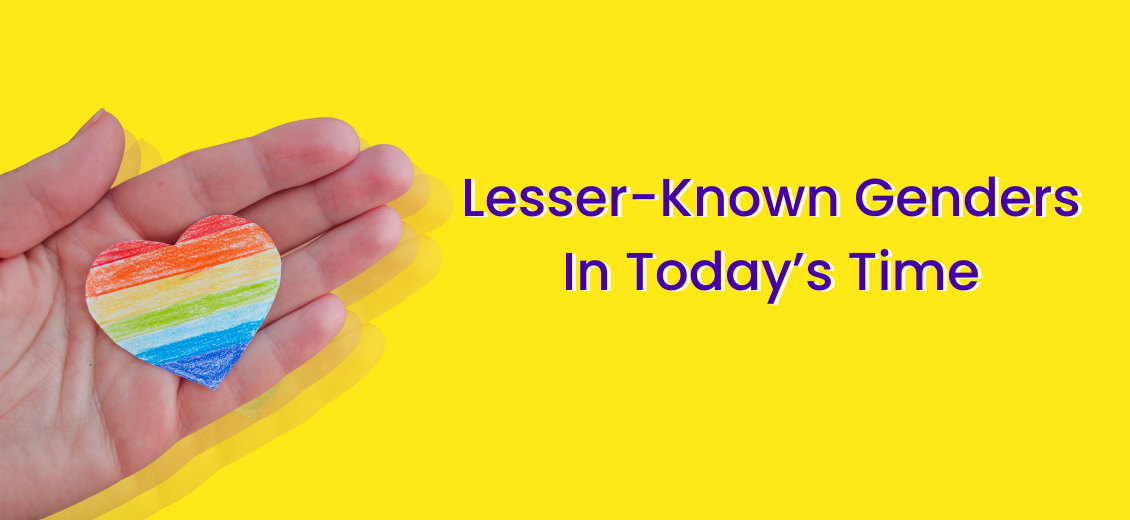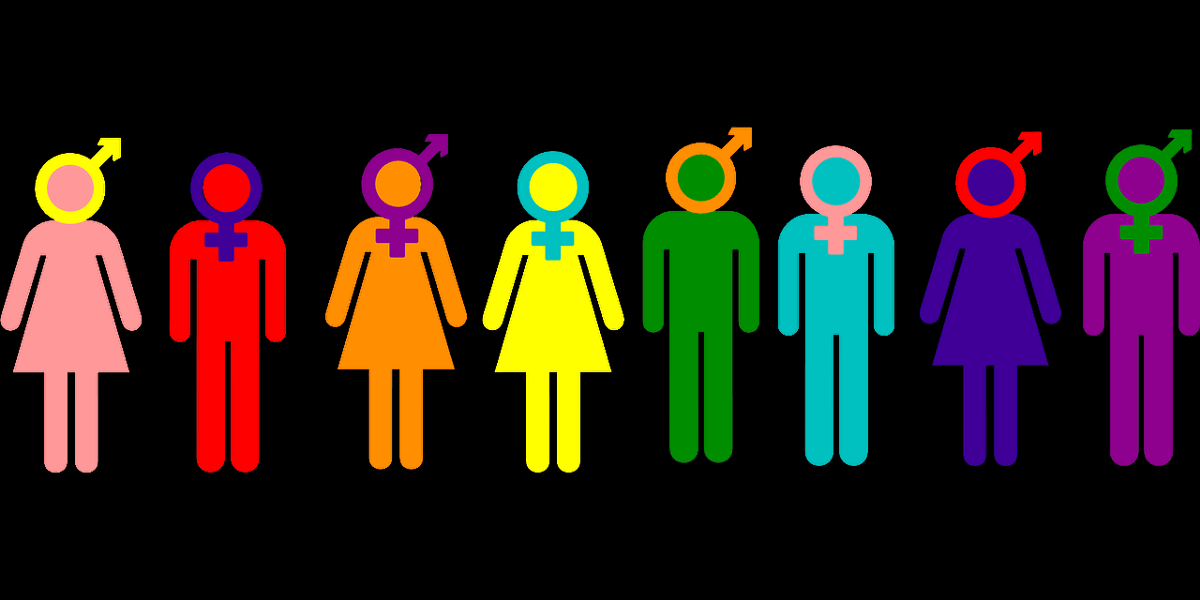Lesser-Known Genders In Today’s Time
Blogs Home
- 01 Sep 2022

In a world filled with kaleidoscopic thoughts and social conformity, a large number of people have trouble figuring out how to deal with the ever-changing environment we are, more often than not, subjected to. One of these constantly changing social constructs is the perception of genders in a society which is struggling to move forward with the rest of the world, in terms of social thoughts and culture.
The constantly interchanged words - gender and sex - are quite different from each other.
What is the difference between sex and gender?
The word ‘sex’ refers to sex assigned to a person at birth based on physiological characteristics, including genitalia and chromosome composition. The person is usually classified- as male, female or intersex. The assigned sex is a person’s ‘natal sex.’
However, gender is what a person socially identifies himself/herself as. Gender, unlike sex, is not binary. It is a broad spectrum. A person can identify at any point on the spectrum scale or not identify within it, at all.
The World Health Organisation states that “Gender refers to the socially constructed characteristics of women and men, such as norms, roles, and relationships of and between groups of women and men. It varies from society to society and can be changed.”
Hence, the concept of sex is more rigid than gender.
Difference between heterosexuality and homosexuality
The word ‘hetero’ comes from the Greek word ‘heteros’ which means “the other (of two), another, different, second; other than usual.” Heterosexual people are sexually or romantically attracted to the opposite sex. Heterosexual men are attracted to heterosexual women and vice versa. They are also referred to as ‘straight men’ or ‘straight women’.
Homosexuality is when two people of the same sex are attracted to each other. The word ‘homo’ is derived from the Greek word ‘homos’ which means ‘the same.’ It is a sexual orientation. Homosexual men are attracted to men and homosexual women are attracted to women.
Difference between Bisexuality and Asexuality
Bisexual people are sexually or romantically attracted to both sexes. The word ‘bisexual’ was initially used to describe people who had both, male and female parts. However, over time the meaning has modified into being attracted to both genders instead. A man identifying as bisexual can be attracted to any sex and vice versa.
Asexuality refers to the phenomenon of not being sexually attracted to any sex. The word is a combination of the prefix ‘a-’ and ‘sexual’. It may or may not be considered a sexual orientation.
Gender identity and expression
Gender identity is how a person perceives themselves. They can be cis-gender (someone who identifies with the gender assigned at birth or non-binary; part of the LGBTQ+ community).
It is the personal sense of identity that one has. It may or may not fit the gender spectrum.
Gender expression, on the other hand, is how one portrays themselves within societal conformity. It may or may not be socially acceptable by every single member of society.
For example, a person might identify as non-binary but express themselves as a man to the outside world. Society has a long way to go when it comes to accepting the wide spectrum of genders with new ones being identified as more people are being vocal about their gender and sexual preferences.
Some of the lesser-known gender identities
Listed below are some genders that people, in general, are not aware of. Let’s have a look at them.
Agender
A person who does not conform to a particular gender and does not identify as any one of them.
Adamas gender
A gender that is undefinable. People identifying with this gender do not categorise in any particular gender.
Agenderflux
A person who is mostly agender with brief shifts of belonging to other genders.
Amaregender
A person whose gender identity depends on who they are attached to.
Ambigender
A person with two specific gender identities without any fluctuations or fluidity.
Ambonec
A person who identifies as both man and woman but does not belong to either of the identities.
Androgyne
A person whose appearance is neither categorised as feminine nor masculine.
Aromantic
A person who does not have any romantic interest in someone they are sexually attracted to.
Bisexual
A person who is sexually and romantically attracted to someone of the same or opposite sex.
Boyflux
A person who identifies as male but has varying degrees of masculinity on the scale of male to agender.
Butch
A person with masculine tendencies or qualities that are normally not seen.
Cavusgender
A person who identifies with cavusgender feels close to one gender when depressed and to another one when not.
Cisgender
A person who identifies with the sex and gender that they were given at birth.
Cloudgender
A person whose gender cannot be identified due to depersonalization and derealisation disorder.
Collgender
A person who has various gender identities at the same time.
Commogender
A person who does not identify as cisgender but continues to identify as one for some time.
Condigender
A person who experiences their gender only under certain circumstances.
Deliciagender
A person having multiple genders but preferring one over the others.
Demifluid
A person who has multiple genders, some fluid and some static.
Demigender
A person with some traits of one gender identity and partial traits of another identity.
Domgender
A Domgender person has multiple gender identities but one is more dominant than the others.
Duragender
A person with multiple gender identities but one lasting longer than the others.
Existigender
A person who only realises their gender when they make conscious efforts to recognise it.
Femme
A person who identifies as a lesbian and expresses themself in feminine techniques and appearances.
Gay
A person (male) who is attracted to another male.
Gemigender
A person with two gender identities that are opposites but somehow work together.
Gender expansive
A person who has a slightly more flexible gender identity than a typical gender binary.
Genderfluid
A person whose gender identity changes from time to time and place to place.
Gender outlaw
A person who does not conform to society’s idea of their biological sex.
Genderqueer or non-binary
An umbrella term for a person who does not fit into the gender binary.
Intersex
A person with the condition where they are born with both, male and female parts, i.e. hermaphroditism.
Lesbian
A person (female) who is sexually and romantically attracted to a woman.
Masculine of centre
A person who has a tendency to be more masculine on the gender spectrum. It is usually used by people who are assigned female sex at birth but are not restricted to it.
Omnigender
A person who identifies as omnigender, experiences and possesses all genders.
Pansexual
A pangender person may shift between identities over time or feel as though they have one all encompassing identity that is static/unchanging.
Transgender
A person whose gender identity differs from the sex that they were assigned at birth.
Two spirit
A term used within some indigenous communities, encompassing cultural, spiritual, sexual and gender identities.
How many gender identities are there in total?
The number of gender identities present in the world at any given time is always fluctuating. There are hundreds of identities within the spectrum and more beyond it. Hence, no one can say how many gender identities are present at any given time.
To conclude, gender is a wide spectrum with various subsections and categories. It takes one some time to come to terms with their sexuality in a world where no relationships beyond heterogeneous ones are socially accepted. A new generation has come to wake and with it comes acceptance and love.
Maybe this will be the breakthrough that the community needs from the world.

Jess Doshi
Jess Doshi is currently pursuing her Bachelor's degree in Arts. Apart from reading, she makes a conscious effort to do what she can for society. She aims to help the world around her in the best possible way- writing.
Sources
Gahagan, J. (Jacquie). (2021, July 14). The difference between sex and gender, and why both matter in health research. The Conversation. https://theconversation.com/the-difference-between-sex-and-gender-and-why-both-matter-in-health-research-162746
McLeod, S. (2016). What is Conformity? | Simply Psychology. Www.simplypsychology.org. https://www.simplypsychology.org/conformity.html#:~:text=Conformity%20is%20a%20type%20of
Newman, T. (2018, February 7). Sex and gender: Meanings, definition, identity, and expression. Medical News Today. https://www.medicalnewstoday.com/articles/232363
Zambon, V. (2020, November 6). Types of gender identity: Types and definitions. Www.medicalnewstoday.com. https://www.medicalnewstoday.com/articles/types-of-gender-identity
THE SPECTRUM. (n.d.). https://www.thetrevorproject.org/wp-content/uploads/2017/09/Spectrum-B.pdf
World Health Organization. (2019). Gender and health. World Health Organization. https://www.who.int/health-topics/gender#tab=tab_1
Stonewall. (2020, May 28). List of LGBTQ+ Terms. Stonewall. https://www.stonewall.org.uk/help-advice/faqs-and-glossary/list-lgbtq-terms
Terms and Definitions - Spectrum - Loyola University Maryland. (n.d.). Www.loyola.edu. https://www.loyola.edu/department/lgbtq-services/resources/lgbtq-terms-definitions
https://www.facebook.com/WebMD. (2002, February 6). Sexual Orientation. WebMD; WebMD. https://www.webmd.com/sex-relationships/guide/sexual-orientation
Shaziya Allarakha, MD. (2022, February 2). What Are the 72 Other Genders? MedicineNet; MedicineNet. https://www.medicinenet.com/what_are_the_72_other_genders/article.htm





